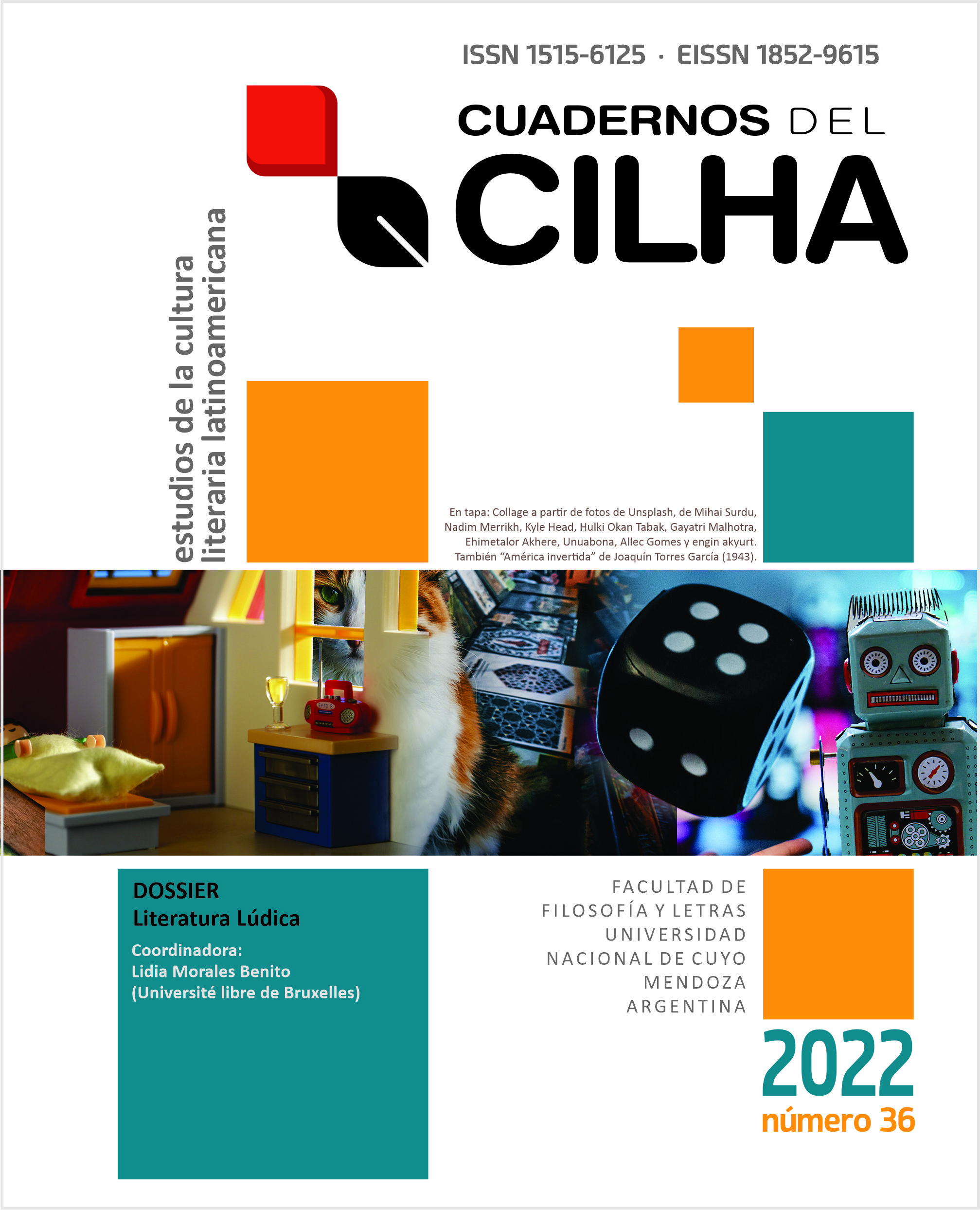Luisa Valenzuela: cuentos que instruyen para jugar a los villanos
DOI:
https://doi.org/10.48162/rev.34.039Palabras clave:
Valenzuela, Juego, Lenguaje, Humor, Técnicas discursivasResumen
La escritora argentina Luisa Valenzuela reunió en el libro Juego de villanos un amplio número de sus relatos más breves. Entresacando textos de libros ya publicados y añadiendo algunos nuevos, el libro, publicado en 2008, permite leer en un nuevo contexto aquellos cuentos y microrrelatos. El resultado es una propuesta que pone en primer plano el humor y convierte el juego, presente en el título del libro, en el camino para acercarse a estos textos. Partiendo de la teoría sobre la naturaleza del juego como componente esencial de nuestro ser social y de su ineludible relación con el lenguaje, proponemos un acercamiento a las técnicas utilizadas por la autora para componer estos diversos textos, ver cómo juega y cómo invita al lector a participar o lo atrapa sin previo aviso. A través del análisis de varios de los microrrelatos se ofrece una vía para acercarse al resto de los textos y establecer la vinculación entre juego, humor y compromiso con una acuciante realidad que margina, reprime y destruye y en la que la risa se convierte en un elemento transformador.
Citas
Aranzueque, G. (2012). Cuerpo y texto. Universidad Nacional de Colombia.
Bianchi, S. (2017). Zoología y lenguaje: micropoética a lo Valenzuela. El vértigo de la escritura. En I. Chikiar Bauer (comp.), Jornadas Luisa Valenzuela (págs. 87-100). Edición digital https://docplayer.es/54734424-El-vertigo-de-la-escritura.html
Caillois, R. (1986). Los juegos y los hombres. La máscara y el vértigo. Fondo de Cultura Económica.
Carreras, C. (2017). Del homo ludens a la gamificación. Quaderns de Filosofía, IV(1), 107-118. https://ojs.uv.es/index.php/qfilosofia/article/view/9461/9472
Cortázar, J. (1991). Rayuela (J. Ortega y S. Yurkievich, eds.). Archivos.
Díaz, G. (1996). Introducción. En G. Díaz y M. I. Lagos (eds.), La palabra en vilo: narrativa de Luisa Valenzuela (págs. 9-12) Editorial Cuatro Propio.
Glantz, M. (1996). Reflexiones sobre Simetrías. En En G. Díaz y M. I. Lagos (eds.), La palabra en vilo: narrativa de Luisa Valenzuela (págs. 247-252) Editorial Cuatro Propio.
Grijalva Monteverde, D. (2013). El erotismo lúdico: fiesta del lenguaje y la imaginación. En P. Popovic Karic, F. Chávez Pérez (coords.), Luisa Valenzuela. Perspectivas críticas. Ensayos inéditos (págs. 65-103) Miguel Ángel Porrúa. https://www.cervantesvirtual.com/obra-visor/el-erotismo-ludico-fiesta-del-lenguaje-y-la-imaginacion-933401
/html/474df660-4334-405c-8550-62cae27631f7_5.html#I_0_
Guillén, J.C. (14 de enero, 2015). El juego, un mecanismo natural imprescindible para el aprendizaje. Escuela con cerebro. https://escuelaconcerebro.wordpress.com/2015/01/14/el-juego-un-mecanismo-natural-imprescindible-para-el-aprendizaje/
Huizinga, J. (1994). Homo Ludens. Alianza.
Johnson, M. (1991). El cuerpo en la mente. Editorial Debate.
Jones, S. (1995). The Fairy Tales. The Magic Mirror of Imagination. Twayne Publishers.
López de Martínez, A. (1999). Feminismo y literatura en Latinoamérica: un balance histórico. En R. Forgues (comp.), Mujer, creación y problemas de identidad en América Latina (págs. 267-278) Universidad de los Andes.
Martínez, N. Z. (1994). El silencio que habla: aproximación a la obra de Luisa Valenzuela. Ediciones Corregidor.
Morales Benito, L. (2012). Las reglas del juego: teoría y práctica del juego en literatura. Les Ateliers du SAL, 1-2, 271-281.
Morales Benito, L. (2021). El arte del funámbulo. Universidad Iberoamericana Puebla.
Muñoz, W.O. (1996). Luisa Valenzuela y la subversión normativa en los cuentos de hadas: “Si esto es vida, yo soy Caperucita Roja”. En G. Díaz y M.I. Lagos (eds.), La palabra en vilo: narrativa de Luisa Valenzuela (págs. 221-246) Editorial Cuatro Propio.
Nancy, J.-L. (2003). Corpus. Arena Libros
Nietzsche, F. (1980). Sobre el porvenir de nuestras escuelas (C. Manzano trad.). Tusquets.
Noguerol, F. (2006). Luisa Valenzuela: relatos integrados en el infierno de la escritura. En P. Brescia y E. Romano (coords.). El ojo en el caleidoscopio (págs. 389-412) Universidad Nacional Autónoma de México.
Noguerol, F. (2008). Prólogo: Luisa Valenzuela, baile de máscaras. En L. Valenzuela, Generosos inconvenientes (págs. 7-22) Menoscuarto Ediciones.
Noguerol, F. (2012). Luisa Valenzuela: maestra de intensidades. En A. Calvo y J. de Navascués (eds.), Las fronteras del microrrelato. Teoría y crítica del microrrelato español e hispanoamericano (págs. 221-234) Iberoamericana.
Reyes, A. (2009). La experiencia literaria y otros ensayos. Fundación Banco Santander. Disponible en: http://es.scribd.com/doc/49230482/LA-EXPERIENCIA-LITERARIA
Rodríguez, S. (1986). Hallazgo de las piedras [canción]. En Causas y azares. Sonoland.
Searle, John (1994). Actos de habla. Ensayo de filosofía del lenguaje. Planeta de Agostini.
Stendhal (2018). El rojo y el negro. (P. Ruiz Ortega trad.). Akal. Disponible en Digitalia. https://www.digitaliapublishing.com/a/55217
Valenzuela, L. (2008). Juego de Villanos. Thule Ediciones.
Valenzuela, L. (2009). Casa tomada: escritoras y escritura. En M. Á. Encinar y C. Valcárcel (coords.), Escritoras y compromiso.
Literatura española e hispanoamericana de los siglos XX y XXI (págs. 123-136) Visor.
Valenzuela, L. (2018). Biografía dialogada con Gwendolyn Díaz Ridgeway. Cervantes Virtual. http://www.cervantesvirtual.com/nd/ark:/59851/bmc0933884
Wilson, R. R. (1990). In Palamedes’ Shadow. Explorations in Play, Game, & Narrative Theory. Northeastern University Press.
Winnicott, D. (1982). Realidad y juego. (F. Mazía, trad.). Gedisa.
Descargas
Publicado
Cómo citar
Número
Sección
Licencia
Derechos de autor 2022 Raquel Arias Careaga

Esta obra está bajo una licencia internacional Creative Commons Atribución-NoComercial 4.0.












































